Abstract
The influence of scientific research in art is not exclusively a contemporary phenomenon. The Alberti model of pictorial representation based on perspective, as well as the social consideration of art, included Painting among the liberal arts because of the mathematical principles of geometry which it was founded on. For more than 400 years, perspective would be called the “science of art” and it established, almost in a unitary way, a representative model that has characterised the artistic production and the training of artists until the fracture represented by the art of the twentieth century. The discussion about the preeminence of the rational model in the artistic practice based on the aesthetic or historicist parameters has been the topic of important debates on teaching and practising the Fine Arts particularly during the age of Enlightenment. Our contribution aims to reflect on the role that perspective has regained in the contemporary artistic practice, not only as a graphic resource for representation but also as a reflective element in itself. Although a hundred years ago for most of the avant-garde movements of the twentieth century it could symbolise a reality to be fought against, its use in contemporary art has transcended from pure methodology to its inclusion among the new conceptual landscapes, intervening as a fundamental part of artistic discourse. Therefore, we will study the work of contemporary artists whose pieces highlight a review of the spatial perspective; so that the three-dimensional space becomes a protagonist element of the same representation.
PUBLIC INTEREST STATEMENT
Can we obtain scientific knowledge from visual art? This is a quite difficult question to answer. Firstly, a difference has to be made between scientific and non-scientific knowledge. Something we are sure about is that the study of space in art, as well as the representation of space, need a clear scientific basis using mathematics, psychology and optics. In this article, we introduce a great selection of contemporary artists in whose works of art perspective and the representation of space is a crucial issue. After reading, we can clarify the main role that perspective has played in art, and the impact that this fact has on contemporary art. This means that scientific knowledge can be learnt from the study of contemporary art. The artists selected in this article are university educated, and this permits us to grasp the importance given in Fine Arts faculties and schools to reviewing scientific and historical methods.
1. Introduction
The main purpose of this article is to demonstrate the connections that exist between art and knowledge. Firstly we will introduce the kind of knowledge that works of art offer, and secondly we will focus our discourse on the use of scientific knowledge for artistic creation. The studies on optics, spatial perception and representation of space that over the centuries have taken place, have been used by artists for the creation of works of art. Despite the difficulties between the distinction of the scientific and non-scientific value of the knowledge which art offers, mathematical perspective has played an essential role as a sample of scientific value in art. Thus, with the analysis of the use of the fundaments of perspective and the perception of space in the contemporary artistic work from a selection of artists, we will put in value the scientific side of contemporary art, which is taught and learned in the faculties of Fine Arts.
We have applied a deductive methodology, since we have started from general sources and bibliographies in order to specify through the final conclusions; notwithstanding the comparative analysis has been essential, as it has allowed us to determine the ideal selection of artists who exemplify the fundamental concepts to represent our purpose. With the aim of locating the main sources, we have studied specific catalogues -principally-, books, and scientific articles about the essential topics. These works can be consulted throughout the text. The collection of data from these sources establishes a basic support from which we have reached the apprehension of the ideas and knowledge that form the foundations of the final conclusions.
About the limitations, we consider that in spite of having included a fine selection of artists, the rich and varied current artistic panorama offers multiple figures that could have been added to the study. However, due to the limitations of an article, the selection had to be specific and limited. We have proceeded on the basis of a selection of artists that, while diverse and defined, clearly expresses the connection of their work with space and its representation and perception. This could give rise to future articles in which aspects related to the main topic of the present are analysed, which could enrich and deepen the conclusions obtained in the first one.
2. Art and knowledge
In the area of knowledge production, and particularly in the area of research typically undertaken in Fine Arts faculties, it is difficult to make a precise distinction between procedures with a scientific grounding and others where this grounding cannot be found. So, can we therefore define a boundary that enables us to differentiate artistic from scientific in the context of the creation and research typical of Fine Arts faculties? Or, how do we define the scientific nature of a piece of art? (Harrington, Citation2013). Research into on artistic practice requires a method for bridging the gap between artistic knowledge and knowledge that has always been termed scientific but, as pointed out above, defining the boundaries is a very complex task. In today’s society, the vast diversity of knowledge has been transformed by moving beyond predetermined “metanarrativeFootnote1” approaches, overtaken by postmodernity; this makes the interdisciplinary nature of research essential in most areas of research, and all the more so in the artistic domain.
Cognitivism, or the psychology of knowledge, claims that art produces knowledge. But what type of knowledge does it produce? As argued by Gaut (Citation2005), -who differentiates between epistemic issues and aesthetic issues in cognitivism-, when trying to establish what kind of knowledge can be received from looking at a piece of art: the moral, philosophical, interpretative, practical, experimental and actual knowledges are examples from epistemology. The problem is that the person looking at a piece of art finds it difficult to express what they have learned consciously from it, or at least to comment on it in any way other than the superficial or banal, even though they are aware that art offers so much more. It is difficult to find a methodology with which a specific knowledge could be demonstrated scientifically. To be able to find, you have to know how to look. Art can offer knowledge arising from empathy when interpreting an artwork, and it can also offer knowledge about the here-and-now linked to society’s collective morals. It can thus be an example of ways of behaving, educating and stimulating the imagination and creative capacity.
Still on the subject of cognitivism, art can also offer knowledge from aesthetics, but this is more difficult to demonstrate -“Once we have disentangled the two claims of cognitivism, we can see that proving the epistemic claim may well be easier than many anti-cognitivists have supposed, while proving the aesthetic claim may be harder than many cognitivists have realized” (Ibid.),—considering that art does not need to reveal real facts in order to keep its artistic values. Even so, we can learn aesthetics through contemplation, as it is claimed by many art-lovers, who hold that contemplation serves to train seeing and tastes. Professor of philosophy Richard W. Miller defends aesthetic pleasure as being similar to knowledge, comparing the simple pleasure of disinterested knowledge with the aesthetic experience typical of art. “Unless, and it is unlikely, philosophical discussions on aesthetic value have all been completely mistaken, aesthetic value must be based on something similar to the enjoyment gained during a knowledge acquisition process” (Miller, Citation2001). We uphold that sometimes, aesthetic value can be appreciated through artistic knowledge. We could take the approach that aesthetic pleasure is the pleasure of knowledge, a specialised knowledge typical of art. Yet even so, we can see that this kind of knowledge is fairly relative and does little to bridge the gap between artistic practice and scientific research.
As we have argued, it is difficult to categorise artistic practice solely from the scientific perspective, and one of the reasons could be the lack of researcher specialisation in particular fields, as stated in Art and Knowledge (Gaut, Citation2005): “There are no distinctive artistic truths, as there are scientific ones: whereas there are scientific experts, a scientific method, and truths that only science can provide, art has no artistic experts”. Scientific enquiry seeks to prove specific hypotheses, and artistic enquiry often encompasses quite complex and general areas. This does make well-defined results difficult to achieve, but does not mean that there are no experts in certain scientific areas, or that artistic practice is unable to offer specific and well-defined knowledge.
We do not believe that the difficulty lies in the method, or in the system of practice, or in the way this knowledge is offered, but rather that the difference between the ability to learn the knowledge of artistic and non-artistic practice research lies in the ability of individuals receiving the message to understand its content. It is therefore a question of a weak point in art culture, of being unfamiliar with the medium and the means of deciphering the concepts or techniques. In our opinion, what is required for a fuller recognition of artistic output is for its receivers to be fully trained to evaluate the artistic phenomenon, both during the initial stage of analysis and ultimately to able to understand it. Moreover, we must not forget that scientific knowledge has to be demonstrable and also empirical, based on experimentation and observation.
Aesthetic experience and the conceptual content of artworks, show that art offers knowledge which goes beyond innovation, efficiency and transferability, all of which are features linked to scientific enquiry. We might say that Holert maintains that art operates from irrationalism, the hind sideFootnote2 of knowledge, the “hind side of rationalist” (Citation2009). But there are some areas of artistic enquiry which base their knowledge on science in its purest form: optics, mathematics, and psychology, resulting in artworks whose theory and concept content can be transferred from the visual and understood through observation and artistic analysis; as we can read in the following section.
3. Art and scientific value: perspective
Over the 20th century, research into theory has enjoyed a significant role in art due to the rise of vanguard movements. The intellectual effort required by increasingly conceptual art has tied artistic practice even more strongly to the academic domain and art curricula. Yet this link between art and research into theory was not born out of vanguard movements, nor is it exclusive to them; it has existed for centuries. Lineal perspective as an area of study already existed in the Renaissance period, and prior to this artists were already investigating spatial perception and ways of representing space in their artworks. Giotto (1267–1337) used in his spatial representations lines which converge in the centre, but there still were not any vanishing point, so the intuition was his main tool to build the space in his paintings. In the 14th century, artists such as Pietro Lorenzetti (1280–1348) began using diagonal foci in addition to vanishing points to sketch out the ground, or grids in other parts of the design of their paintings, although it was an inexact system. Leon Battista Alberti (1404–1472) was the first intellectual who wrote the first treatise On Painting (“De Pictura”), addressing the topic of mono-focal geometric perspective based on principles of mathematics, constructing space in paintings as a geometrical grid. Before Alberti, the architect Filippo Brunelleschi (1377–1446) had already made some experimental drawings of the Baptistery of Florence using a new methodology with vanishing points, according to the great humanist Giannozzo Manetti (1396–1459), (Wakayama, Citation1980) as Brunelleschi did not leave any writing about perspective. Due to this fact, there are several arguments about the birth of the method. Some experts affirm that the inventor of lineal perspective was Brunelleschi. In contrast, others claim that Alberti was the first one. (Lang, Citation1980).
Piero della Francesca’s treatise On Perspective for Painting, De prospectiva pingendi, (1474) may be considered the continuation of Alberti’s studies, starting from its link to art and focusing more on the mathematical properties which can be found therein. The influence of perspective in painting was such that, by the end of the 15th century, Italian artists adopted it as the hegemonic system for drawing and painting. From this we may infer that in spite of the scientific value of the perspective method, intuition and empiricism were still linked to artistic practice; perspective was used according to the interests of each artist’s creations. The advances in applying perspective in paintings from the Renaissance period must include the contributions of Leonardo da Vinci (1452–1519), who distinguished between various types: natural perspective: “[…] which addresses the perception of relative sizes of real objects in nature” (Kemp, Citation2000); artificial perspective: “[…] (‘prospettiva accidentale’) […] consisting of the painter’s projection of shapes on a plane for foreshortening” (Ibid.); and compound perspective: “[…] based on a combination of foreshortening on the plane and the foreshortening of the plane itself” (Ibid.), (what is known today as anamorphosisFootnote3).
This Renaissance invention revolutionised the ways that artists represented reality in their paintings over subsequent centuries. Knowledge spread outwards from Italy across Europe. Years later, technological advances made representation possible using technical apparatus as an aid for drawing, such as the camera obscura, right up to today’s photography cameras. Vanguard movements in the 20th century rejected this naturalist representation of reality in painting and focused their artistic creation on other concepts, but nevertheless, geometry and the study of shapes remained a constant. Perspective has developed right up to current times, and this has enabled us to make a selection of the most representative contemporary artists who base their work on this concept, applying its principles to their artwork to study how space is perceived and/or represented, producing optical illusions and sensory alterations. They are all university educated, and this permits us to grasp the importance given in Fine Arts faculties and schools to reviewing scientific and historical methods, demonstrating the importance and reality of training and knowledge in the field of research applied to art and closely linked to art practice. Three concepts are combined in the following cases: Georges Rousse, Felice Varini, William Kentridge, István Orosz, Tim Noble and Sue Webster, Esther Stocker, Fred Sandback, and lastly Jorge Macchi.
The two first artists employ big scale anamorphic images seen from a specific point of view in order to eliminate the three-dimensional spatial sensation of the viewer, even though this visual effect is conceptually more relevant for the first than for the second one.
3.1. Georges Rousse (1947), France
During his medical studies in Nice, Rousse also studied professional photography and printing techniques. Professionally, he specialised in photography of architecture. Several years later, his artistic curiosity led to his desire to work on the established relationship between painting and space, influenced by Land Art and the work of Malevich. This is how he started producing his installations.
Rousse’s photographs such as Selestat, 1999, (Figure ), interact with spaces and large surfaces such as walls. His work relates directly to the practical application of the principles of mathematical perspective to large murals in a complex manner, since the painting takes place on the different planes making up the space. Some of his works create flat images whilst others, using different colours, reinforce the depth of space by creating a kind of imaginary tunnel which connects to another space.
Figure 1. Georges Rousse. Selestat. 1999. Painting on architecture. (Artwork copyright © Georges Rousse. Photograph copyright © Bärtschi-Salomon Editions Sàrl y Georges Rousse). (Rousse, Citation2000).
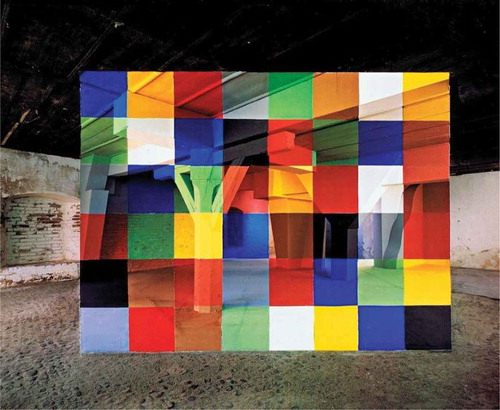
The artist draws, projects, paints and photographs all these works directly relating to vision and perception of the space involved and, at the same time, the space or feeling of space created by the work. Ultimately, the aim of the photography camera is to represent this new space created by artistic intervention. It works as a mechanism to represent an existence which is not real, a blend of illusionism, fiction and representation. It is about placing the concept of reality and how it can be transformed in front of the viewer. His anamorphic drawn images work like trompe l’oeil, as the outcome of his artistic work is photography shot from the exact projection point, obtaining the image with no kind of distortion and which appears to exist as a unit. His method brings to mind the Baroque quadraturaFootnote4 used by artists like Andrea Pozzo (1642–1709) to project his grids onto church ceilings, such as found in St Ignatius Chapel in Rome.
3.2. Felice Varini (1952), Switzerland
Resident in Paris, where he went to study art in the Académie de Vincennes, aged 26. Varini became interested in space at a young age. Before studying in Paris, he worked as a theatre set designer and lighting technician. His work is the result of following minimalist painting and modern abstraction combined with studying visual perception in space. “[…] aesthetic perception in the identifying gaze upon an object […]” (Meinhardt, Citation2012).
Since my arrival in Paris in 1978, both my paintings and my photographs always place the viewer in an active position. My pieces seek to provide a staged space—in a way they invite the viewer to enter the scene and become a party to it (Marques, Citation1998).Footnote5
His artworks are based on applying optical anamorphosis in complex architectural spaces, like in Cercles concentriques excentriques, 2018, (Figure ). Once he has projected the design onto the surface, he pencils in the areas to be filled with colour. The projector is aligned with the fixed vantage point the artist desires, by means of a vertical pendulum: “[…] the big projector […] in the central vantage point, perfectly aligned with the vertical pendulum […]” (Von Drathen, Citation2013).
Figure 2. Felice Varini. Cercles concentriques excentriques. 2018. Adhesive aluminium foil. (Artwork copyright and photograph copyright © Felice Varini). (Varini, Citation2018).
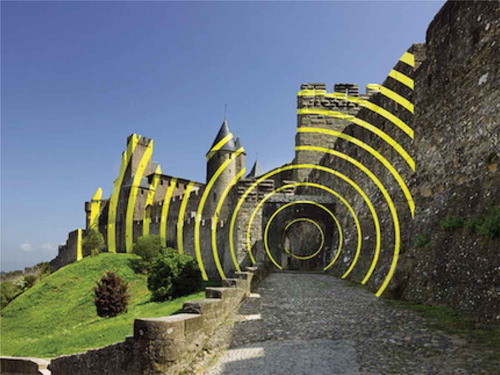
The artist paints simple geometric shapes because the space containing them has complex surface shapes. These variations are what makes the work complex. For the same reason, he uses flat primary colours, black, white and also orange. For Felice Varini, space is synonymous with the ecosystem in which he lives, or with place, the world. Just as many artists have wished to represent space on a plane, Felice Varini uses three-dimensional space as the canvas on which he works directly. And to define his knowledge as regards his work surface, he needs to measure and understand it methodically. Moreover, in spite of using linear perspective for his creations, he seeks to find the way of seeing space in a way other than the Renaissance view.
Unlike Rousse, Varini’s vantage point for projecting the image, and from where the entire shape can be viewed undistorted, is simply any point at all; it makes no difference. “The angle of vision […] is never the goal, but always the starting point for the piece” (Ibid.).Footnote6 The reason why most of his works are recorded by photograph taken from the projection point is simply so that the work will be easier to recognise. For him, this point works like any other, the space being what completes the work, since the artist always expects to be surprised by each fragment he paints and how space will influence them.
The sensations Felice Varini’s work conveys to the viewer will depend on the kind of space he is working in. If it is a narrow corridor, viewers can find themselves completely enveloped by the artwork. However, in an open square, it will be harder to create this effect. We can thus establish the factors involved in viewing his work: the size of the space, the texture of surfaces, the light which the space receives, if it is an indoor or outdoor space, the volume of footfall through the space each day, the possibility of viewing the work from as many vantage points as possible, or how easy it is to locate the image projection point.
Anamorphosis is also employed in the artworks of the two following artists. This time the undistorted image is seen in a mirrored cylinder which reflects the original distorted one.
3.3. William Kentridge (1955), South Africa
He studied Fine Arts at the University of the Witwatersrand, Johannesburg, in 1976; attended the Johannesburg Art Foundation from 1967–78, and the École Jacques Lecoq in Paris from 1981–82. Beyond the social and political themes and modern conceptual content of his works, what interests us is analysing the techniques and methods of representation he uses in his work. As we have done with the other artists commented on here, we present Kentridge’s work given its relationship with perspective and spatial representation. However, in his case, it is not about installations in three-dimensional spaces, but rather anamorphic drawings in short animated films. These comprise successive drawings in charcoal on the same sheet of paper which are then projected onto a surface, which in turn reflects the moving image on a concentric aluminium cylinder where the images can be seen completely undistorted; multiple, moving catoptric anamorphosis.Footnote7
These anamorphic animations require the analysis of the proportions of each of the drawn elements, starting from a concentric frame which gets wider as it moves outward from the centre, so that the boxes of the frame get shorter and wider as they get closer to the edge of the paper and the circumference which defines the surface of the drawing. The base also changes, since the figures do not move above a flat horizon line, but rather the lower boundary is the circumference of the aluminium cylinder. One of these pieces is called What will come (has already come) (Queen of the Night), 2007 (Kentridge et al., Citation2012) (Figure ).
Figure 3. William Kentridge. What will come (has already come) (Queen of the night). 2007. 35 mm film transferred to video, 8:40 mins. Metallic cylinder. (Artwork copyright and photograph copyright © William Kentridge). (Kentridge, Francés, & de Corral, Citation2012).

3.4. István Orosz (1951), Hungary
He studied graphic design at the Academy of Applied Arts in Budapest. He also studied animation at Pannonia Film Studios. In a similar manner to the work of Kentridge, the work of this artist is not related to the viewer’s perception of three-dimensional space. His work does not distort true sense of space, as it works with represented spaces. Orosz draws imaginary scenes with impossible perspectives, creating realities which do not exist and which flout the principles of physics; a principal feature of his drawings are the impossible figures which bring to mind the drawings of Escher, creating optical illusions and anamorphic images which can be read in a number of ways.
He uses catoptric anamorphosis in much of his work, experimenting with image perception. Some of these catoptric anamorphic pieces are interpreted from the image created on the metal cylinder where the drawings on the paper around and beneath it are reflected. Some works, such as A Magically appearing portrait of Jules Verne on the Mysterious Island, 1983 (Figure ), must be interpreted by looking at the “undistorted” anamorphic image on the cylinder, in addition to the non-anamorphic image drawn on the same platform as the anamorphosis, which in some cases creates images which complete each other. An example is the portrait created in the reflection on the cylinder, entirely integrated into the anamorphic landscape of the plane, acquiring a recognisable shape easy to perceive visually. We thus see how the image is distorted at the centre and has an apparently abstract form, but when viewed in its reflection, is recognisable as a portrait.
Figure 4. István Orosz. A Magically Appearing Portrait of Jules Verne on the Mysterious Island. 1983. Drawing on paper and metallic cylinder. (Artwork copyright © István Orosz. Photograph copyright © Al Seckel). (Seckel, Citation2004).
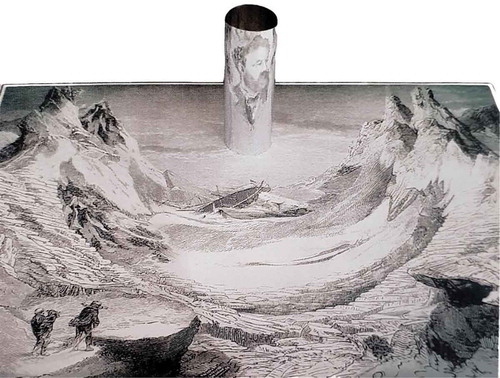
In other pieces, such as Anamorphic body landscapes IV, 1989 (Figure ), the anamorphic image reflected on the cylinder completes the other non-anamorphic drawing on paper positioned in front of it. In this way, the drawing of the leg on one plane is completed by the foot, drawn in distorted form on another plane but which, when reflected, can be entirely recognised by the viewer, and is positioned precisely so that it joins up with the leg.
Figure 5. István Orosz. Anamorphic body landscapes IV. 1989. Drawing on paper and metallic cylinder. (Artwork copyright © István Orosz. Photograph copyright © Al Seckel). (Seckel, Citation2004).
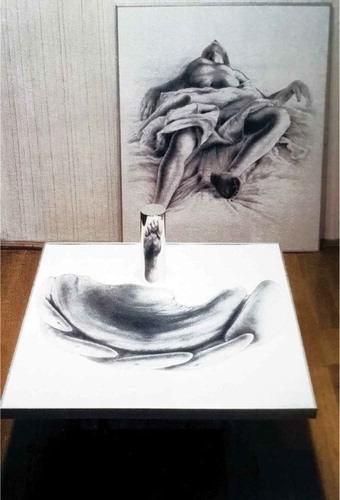
We could consider that technically similar to the work of the two artists above, but in a bigger scale and replacing the mirrored cylinder by a specific shaped shadow on a wall, we find the artistic work of the British couple of artists by the following names.
3.5. Tim Noble (1966) and Sue Webster (1967), United Kingdom
Both obtained a Degree in Fine Arts from Nottingham Polytechnic. Tim continued his studies with an MA in Sculpture at the Royal College of Art in London, and both artists did a Residency at Dean Clough, Halifax, West Yorkshire. (1989–1992).
These artists’ works often convey a harsh criticism of modern consumer society, ego and excessive production. We focus on sculpture works which gather together different materials (like a rubbish tip), strategically positioned and illuminated in such a way as to reproduce a perfectly recognisable silhouette on the space behind them. The work of these artists refers to ways of representing reality: using perspective created through a beam of light, or through a visual line which collides with solid objects, or light chambers and other drawing tools which came along in subsequent centuries, up until today’s photography camera.
Pieces such as The Undesirables, 2000 (Figure ), displayed in the “Apocalypse” exhibition at London Royal Academy, and the piece called The Masterpiece, 2014 (Figure ), displayed in the Saatchi Gallery from 31 May to 6 September 2017 in the “From Selfie to Self-Expression” exhibition, make reference to concepts such as the double, or true and false, or appearance and reality. At the same time they call to mind the methods used during the Baroque period to represent images on the ceilings and naves of different cathedrals and churches, by means of projecting quadraturas using a light source; or the machines created in the 17th century to project people’s profiles with their shadow in order to study their personality (Cabezas Gelabert, Citation2012).
Figure 6. Tim Noble and Sue Webster. The Undesirables. 2000. Trash, electric fan, 3 light projectors & coloured gels and smoke machine. 200 × 600 x 500 cm. (Artwork copyright © Tim Noble & Sue Webster. Photograph copyright © Gestión Cultural y Comunicación S. L.—CAC Málaga). (Noble & Webster, Citation2005).
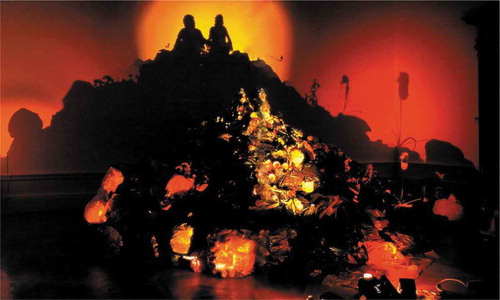
Figure 7. Tim Noble and Sue Webster. The Masterpiece. 2014. (Sculpture, Sterling silver, metal stand, light projector). 153 × 24 x 37.5 cm. (Artwork copyright © Tim Noble & Sue Webster. Photograph by the authors).
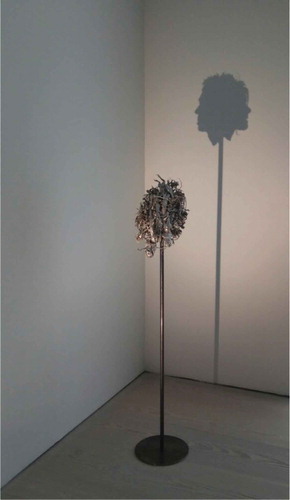
Differently and finally, the last three artists analysed in this article are characterised by the employment of visual illusions with the objective of exaggerating the spatial sensation in the viewer’s gaze.
3.6. Esther Stocker (1974), Italy
She studied at the Akademie der Bildenden Künste in Vienna 1994; the Accademia di Belle Arti di Brera in Milan in 1996; and the Art Center College of Design in Pasadena, California, in 1999.
The works of Esther are based on geometry and its derivatives, but in her installations she turns this scientific principle into something more unstructured, creating space designs which use imbalances to distort the viewer’s spatial perception and create new experiences from new thoughts. You might say that her work stimulates the imagination. It also makes reference to the grid in Western painting, reflecting reality in a simplified manner. This grid makes reality uncomfortable, dehumanising it and representing it as another dimension.
Through her work, Esther also talks about knowledge and the ways it is constructed: “Knowledge is not always gained by adding information, it can also be created by subtraction” (Fiore). This reflects the scope of art beyond the simple pleasure of enjoying it aesthetically, being a mechanism which invites us to create new ideas. Like the work of Felice Varini, her work offers the possibility of interpreting reality in multiple ways: “The things we know should be challenged, they should be looked at from different perspectives” (Ibid.).
The relationship between mathematics and artistic enquiry is reflected in the artist’s work, as she herself says in the interview with Alberto Fiore: “Yes, as part of my work I have also meditated on the question of numbers. We cannot free ourselves from numbers, especially if we have to deal with geometry” (Ibid). Even so, the artist calls for the need for the “social”, or non-scientific in the strictest sense, for this other scientific part of reality to be able to exist.
Unlike the work of Felice Varini, her installations are not site-specific as they are designed for neutral spaces, which means that in her work, space is understood in the most general sense. Contours of Thinking—shiko no rinkaku, 2016, (Figure ), is an example. Esther’s installations attempt to cross the physical and perceptive limitations of space for the subject in the conceptual sense, from their imagination, and at the edge of their logical comprehension abilities, permitting it to be perceived. What she ultimately achieves is to transfigure spatial perception through artistic intervention; not forcing space, but rather altering its logical composition from the surface, without entering the underlying structures.
Figure 8. Esther Stocker. Contours of Thinking—shiko no rinkaku. 2016. Mixed media. (Artwork copyright and photograph copyright © Esther Stocker). (Stocker, Citation2018).
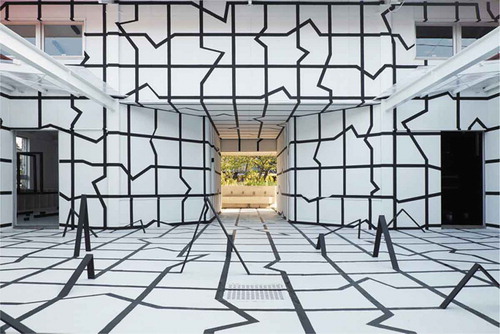
3.7. Fred Sandback (1943–2003), United States
He studied philosophy at Yale University, and subsequently sculpture at Yale School of Art and Architecture.
The main material used by Sandback for his art installations is acrylic thread which configures the exhibition space and turns it into part of the piece itself (Figure ). We use the term installations to refer to Sandback’s works, although he himself did not perceive them in this way, but rather considered that the space containing his threads was as important as the threads themselves. Even so, we take them to be intervened spaces which ultimately form a unit with the intervention. Like the works of Varini or Rousse, colour also has its place although it does not play a leading role; what is really important in his work is the dialogue between space and content, space and the sculptures it contains. This is why his work can be conceptualised from drawing, due to the lines created by the threads, and from sculpture due to the three-dimensional nature of these lines. With this thread, the artist draws different, simple geometric shapes in space in the form of outlines, structuring new psychological spaces for viewers of his work.
Figure 9. Fred Sandback. Untitled. 1987. Thread. (Artwork copyright © Fred Sandback. Photograph copyright © The State of Frend Sandback, New York). (Sandback, Citation2017).
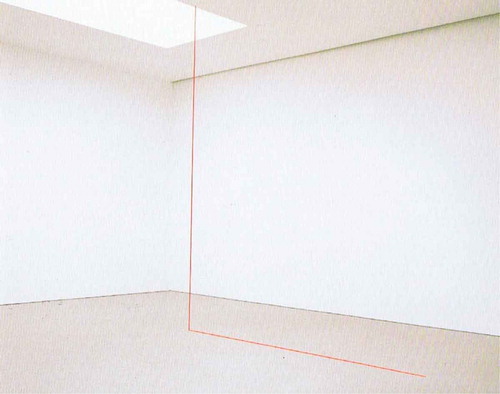
These spaces are analysed in terms of the sensations they convey through the relationships they create, which give rise to visual illusions created by the simple, minimalist forms that characterise his work. He uses what is simple to pose a visual question, or an artefact worth attention and thought-provoking as regards its relationship with perception and space. We can say that Sandback has been able to develop the structural value that the line has for configuring space. In the same way that lines drawn on a plan can create the feeling of space by using different vanishing points in perspective composition, Sandback’s threads are positioned using concepts as basic as scale, proportion and harmonious composition. This brings to mind the search for beauty in Renaissance art: “Whatever beliefs or suspicions individual professionals might have had, perspective was, at the deepest level, the search for divine and perfect harmony, and perfect beauty” (White, Citation1994).
3.8. Jorge Macchi (1963), Argentina
He studied at the National School of Fine Arts in Buenos Aires, Argentina. His artistic output is fairly multidisciplinary in nature, which is why we are going to look at a few of his works in which the concept of space, perspective and perception comes into play, in the same way as with the other artists whose work we analyse in this paper.
The first of them is Perspective, 1991, (Figure ). We can see that from his artistic career’s beginning, he is interested in perspective. This artwork is an installation made with different materials such as ropes and cement blocks, specially distributed in the space and over the wall, in order to simulate a corridor seen in conical perspective, which has been closely studied with the materials and the space. As we have seen with the other artists examined here, Macchi makes the white walls of the architectural space a component of his work, intervening in the space and altering how viewers of his pieces perceive it.
Figure 10. Jorge Macchy. Perspective. 1991. Installation. (Artwork copyright and photograph copyright © Jorge Macchi). (Macchi, Citation2012).
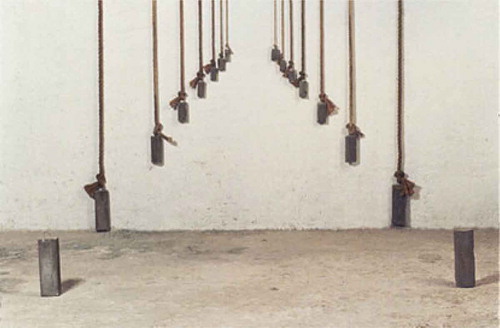
Vanishing Point, 2005, (Figure ), and Hotel, 2007 (Figure ), leave sculpture behind and move into painting. They show forced perspectives of modular grids made up of the same element repeated on the wallpaper. In the first, perspective is accelerated as the paper moves towards a corner of the exhibition room. With this visual play, viewers think they are perceiving a much deeper space if they allow themselves to be immersed in a single design. In the second piece, Hotel, the design does not change in terms of its proportion, but rather in terms of its darkness, so that it is entirely dark in the centre of the composition where the wall light fitting is, and then gets paler and paler as it moves outward, finally blending into the white background and disappearing. Through this kind of pictorial design, the artist manages to create the illusion of a convex volume on a vertical plane.
Figure 11. Jorge Macchy. Vanishing Point. 2005. Acrylic painting on wallpaper on wall. (Artwork copyright and photograph copyright © Jorge Macchi). (Dahelberg et al., Citation2006).
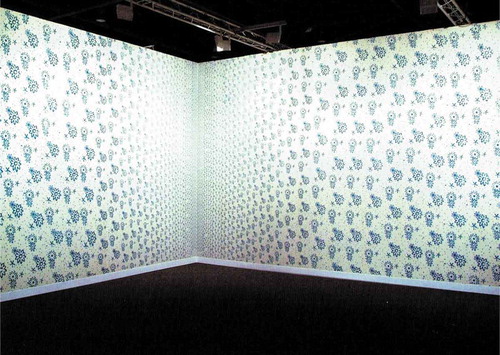
Figure 12. Jorge Macchy. Hotel. 2007. Acrylic painting on wall and lamp. (Artwork copyright and photograph copyright © Jorge Macchi). (Macchi, Citation2012).
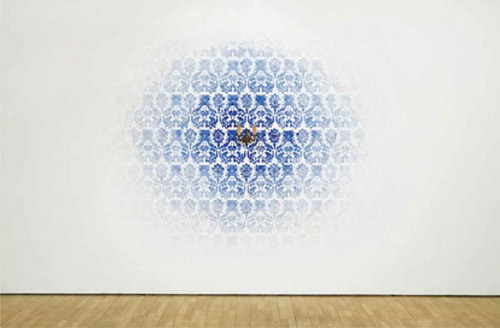
As we can see from the three artworks mentioned, light is the main element, it is what distorts spatial perception and brings the work to life, whether literally as is the case with Fuegos de Artificio, or metaphorically as is the case with Vanishing Point and Hotel. In the latter two, the white of the wall represents the dark void, although it is white, since it is this metaphorical light which enables us to see objects, whilst white, as a metaphor of darkness, dilutes reality and conceals it. In Macchi’s work, light is presented as revealing appearances and what is hidden.
4. Conclusions
We can draw various conclusions from the analysis of these modern artists, whose work requires study of methods of representation such as perspective, which paves the way for anamorphosis, and the transformation of space through its perception, creating visual illusions which oblige us to reconsider the knowledge we acquire through the use of sight.
First off, we highlight the difficulty of distinguishing between scientific and non-scientific methods in research into artistic practice in itself. Setting the boundary creates a conflict, yet this notwithstanding, it is clear that art is able to disseminate any kind of knowledge from aesthetic and from epistemology. Studies on art should emplace more emphasis on the methodology that individuals employ to receiving the messages from art’s content. Having an obvious methodology would bring art closer to scientific knowledge.
We have seen that some areas of artistic enquiry such as the studies of space and perspective, which knowledge is based on mathematics, psychology, optics and architecture, create a link between art and science in its purest form. From the Renaissance period until the present, mathematical perspective has been used by artists in order to create their works of art. Artistic production is a method of knowledge production, so the resulting artworks function as containers of knowledge, and for their creation, knowledge relating to scientific enquiry. Studies of the perception and representation of space are currently included in contemporary artistic discourse according to the artists mentioned in this article. They all visually represent how contemporary art continues to use the theory and practice of the building blocks of science, art, and the history of both disciplines. Specifically, we can learn about how to eliminate the sensation of three-dimensional space analysing the impressive artworks of Felice Varini and George Rousse. Artists who employ anamorphosis in their creations, as well as William Kentridge and István Orosz. These two in a different way, catoptric anamorphosis allow us to be conscious of the capacity of images to transform shapes through optics. These kind of visual illusions are also very close to Tim Noble and Sue Webster’s light effects. Finally, we encounter Esther Stocker, Fred Sandback and Jorge Macchi, who employ the visual illusions with the objective of exaggerating the spatial sensation of the viewer’s gaze.
Additional information
Funding
Notes on contributors
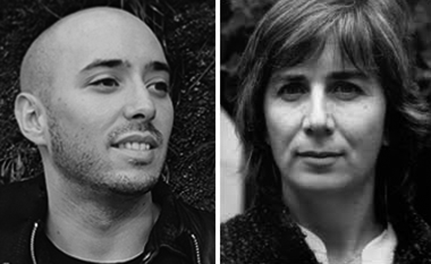
Inmaculada López-Vílchez
Inmaculada López-Vílchez is a tenured lecturer in the Drawing Department of the Faculty of Fine Arts at the University of Granada in Spain. Her research is specialised in perspective and the representation of space applied to art and drawing. Author of numerous articles published in impact journals, as well as relevant books and catalogs of exhibitions.
Jose-Antonio Soriano-Colchero is a PhD student and lecturer-in-training in the Drawing Department of the Faculty of Fine Arts at the University of Granada in Spain. His research is specialised in representation of space applied to contemporary art, focussing in particular on anamorphosis. He has participated in several publications in journals, books and catalogs of exhibitions.
Notes
1. Socially accepted events told from a specific point of view for specific aims.
2. As we see in the following quotation.
3. “ANAMORPHOSIS, in Perspective and Painting, a monstrous Projection; or a Representation of some Image, either on a plane or curved Surface, deformed; which at a certain distance shall appear regular, and in proportion”. (Chambers, Citation1728, p. 84).
4. Images mainly painted during the Baroque period on ceilings or walls which are projected from a source of light across a kind of grid which divides de image into regular parts. This system was very useful for artist who needed to create big paintings on big and irregular areas. The ceiling in the St Ignatius Chapel in Rome is a great example of quadratura. Painted by Andrea Pozzo (1642–1709).
5. Quotation by Felice Varini.
6. Quotation by Felice Varini.
7. Anamorphosis based on a mirrored surface through which the viewer is able to see the image without distortion.
References
- Cabezas Gelabert, L. (2012). Las máquinas de dibujar, formulación teórica y uso práctico [Drawing machines, theory formulation and practical use]. In I. López-Vílchez (Ed.), Perspectiva. Entre el Arte y la Ciencia [Perspective. Between art and science] (pp. 131–15). Ministry of Education and Culture. Granada: Regional Government of Andalusia University of Granada. ISBN: 978-84-616-1144-7.
- Chambers, E. (1728). Cyclopedia, ora n Universal dictionary of arts and sciences. Vol. 1. London. [digital version]. The Internet Archive (2011). Retrieved from https://archive.org/details/Cyclopediachambers-Volume1
- Fred Sandback Archive. (2017). Fred Sandback. [website]. Retrieved from https://www.fredsandbackarchive.org/about/
- Gaut, B. (2005, January 27). Art and knowledge. In The Oxford handbook of aesthetics. Oxford University Press. Retrieved from http://www.oxfordhandbooks.com/view/10.1093/oxfordhb/9780199279456.001.0001/oxfordhb-9780199279456-e-25 doi:10.1093/oxfordhb/9780199279456.003.0025.
- Harrington, J. (2013). Can knowledge be found in works of art? [website]. Retrieved from http://runway.org.au/can-knowledge-found-works-art/
- Holert, T. (2009). Art in the Knowledge-based Polis. In e-flux, n. 3, pp. 1–13. Retrieved from https://www.e-flux.com/journal/03/68537/art-in-the-knowledge-based-polis
- Kemp, M.(2000). La ciencia del arte. La óptica en el arte occidental de Brunelleschi a Seurat [The science of art. Optical themes in western art from Brunelleschi to Seurat]. San Sebastián de los Reyes: Ediciones Akal, S. A. Translated into Spanish by S. M. Moreno & J. L. S. Gaspar. ISBN: 8446008661. (First appeared in English in 1990).
- Kentridge, W., Francés, F., & de Corral, M.; Centro de Arte Contemporáneo de Málaga. (2012). William Kentridge: ¿no se unirá usted al baile?: [Exhibition], Centro de Arte Contemporáneo de Málaga 14th February – 13th May 2012. Málaga: CAC. ISBN: 978-84-939376-0-7.
- Kentridge, W., Garza, A., García Canclini, N., & Tone, L.; Museo Universitario Arte Contemporáneo. (2015). William Kentridge: Fortuna. [Catalogue for exhibition held at University Contemporary Art Museum UNAM, 14th March to 21st June 2015]. México D. F.: Author. ISBN: 9788416282166.
- Lang, S. (1980). Brunelleschi’s panels. In M. Dalai Emiliani (Ed.), La Prospettiva Rinascimentale: Codificazioni e Trasgressioni (pp. 63–72). Florence: Layout Matilde Conti (Centro Di). ISBN: 88.70E8-016-5.
- Macchi, J. (2012). Jorge Macchi. [Websie]. Retrieved from http://www.jorgemacchi.com/es
- Madrid: Comunidad de Madrid, Consejería de Cultura y Deportes. (2006). Espacio interior = Inner space: [Catalogue for the exhibition] June - July 2006. Madrid: Comunidad de Madrid, Consejería de Cultura y Deportes. ISBN: 8445128744.
- Marques, M. (1998). Felice Varini. In Varini, F. (au.). (2012). Felice Varini. [Website]. Retrieved from http://www.varini.org/varini/04tex/texa13.html
- Meinhardt, J. (2012).The reality of aesthetic illusion. Felice Varini’s “Blickfallen” - Eye traps. In Varini, F. (au.). Felice Varini. [Website]. Retrieved from http://www.varini.org/varini/04tex/texa05.html
- Miller, R., W. (2001). Tres versiones de la objetividad: Estética, moral y científica [Three versions of objectivity: Aesthetic, moral and scientific]. In J. Levinson (Ed.), Ética y estética: Ensayos en la intersección [Ethics and aesthetics. Essays at the intersection] (pp. 49–98). Bobadilla del Monte: “La balsa de la Medusa”. ISBN: 978-7774-698-0.
- Noble, T., & Webster, S. (2005). The new Barbarians. [Catalogue for exhibition held from 8th April – 5th June 2005]. Málaga: CAC. ISBN: 84-96159-26-4.
- Rousse, G. (2000). Georges Rousse, 1981-2000. [Catalogue for exhibition held at CGAC]. Gèneve: Bartschi-Salomon. ISBN: 2940292027.
- Seckel, A. (2004). Masters of deception: Escher, Dali & the artists of optical illusion. New York: Sterling Pubblishing Company, Inc. ISBN: 1-4027-0577-8.
- Stocker, E. (2018). Esther stocker website. [Website]. Retrieved from http://www.estherstocker.net/
- Varini, F. (2018). Felice Varini. [Website]. Retrieved from http://www.varini.org/varini/doshpdv/dos2018/02-18-hd.html
- Von Drathen, D. (2013). Felice Varini. Place by place. Zürich: Lars Müller publishers. ISBN: 978-3-03778-405-1.
- Wakayama, E. M. (1980). La prospettiva come strumento di visualizzazione dell’ “historia”: Il caso di Masolino. In M. Dalai Emilini (Ed.), La Prospettiva Rinascimentale: Codificazioni e Trasgressioni (pp. 151–164). Florence: Layout Matilde Conti (Centro Di). ISBN: 88-7038-016-5.
- White, J. (1994). Nacimiento y Renacimiento del Espacio Pictórico [Birth and rebirth of the pictorial space]. Madrid: Alianza Editorial. ISBN: 842067124X.
